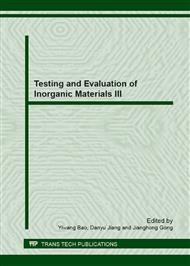p.92
p.96
p.101
p.105
p.110
p.115
p.120
p.124
p.128
Effects of Graphite Mold on Cooling Process of Fused AZS 33# Refractory
Abstract:
This study analyzed effects of different thickness(TH) and thermal conductivity of graphite mold on temperature, liquid phase percentage and conductive heat flux, the cooling process of fused cast AZS 33# refractory could be simulated by using COMSOL Multiphysics software. The results show that: when the graphite mold thickness increased, surface center temperature and liquid phase area of casting decreased gradually, but conductive heat flux increased gradually, the cooling rate of casting increased, which were helpful to form fine crystals near the casting surface. When using conventional graphite mold, the optimum thickness was less than 40mm, while using the high thermal conductivity graphite mold, the optimum thickness was 50mm. So the rapid and homogeneous cooling process of casting could reduce the possibility of material crack and obtain fine crystals structure of material; comparing with conventional graphite mold, high thermal conductivity graphite mold was more beneficial to achieve uniform and fast cooling process to improve the performance and passing rate of products.
Info:
Periodical:
Pages:
110-114
Citation:
Online since:
March 2013
Authors:
Price:
Сopyright:
© 2013 Trans Tech Publications Ltd. All Rights Reserved
Share:
Citation:


